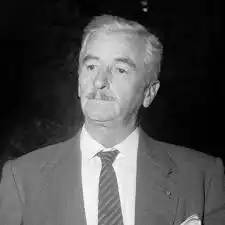Introduction
Having been named after and living in the shadow of his famous great-grandfather, William Clark Falkner, the 1897 New Albany, Mississippi-born author William Faulkner became a famous author in his own right. While he was a young boy at Oxford, William liked reading and drawing, and he soon began composing poetry in the style of the Romantic poets of English literature, such as A.C. Swinburne and Robert Burns. He relocated back to Oxford in June 1962, and on July 6 of that year he passed dead from a heart attack.

Biography
William Faulkner was an immensely popular writer who tried to keep a low profile while he was still living. It’s been said of him that he’s both a Southern gentleman with an oddball personality and a swaggering, arrogant alcoholic. Faulkner’s ancestry is worth discussing because, like the people who influenced his writings, they left an indelible mark on him.
Poem writing came to him as a teen. He dropped out of high school when he was fifteen because he didn’t want to do any work. During World War I, he joined the Royal Flying Corps of Canada. When World War II ended, Faulkner went back to Oxford, Mississippi, where he enrolled in the University of Mississippi as a special student and began contributing to the student newspaper and magazine. While back in Oxford, his reputation as an eccentric writer had already begun to spread.
His first book, 1924’s The Marble Faun, was a collection of poetry that was met with lukewarm reception from critics and readers alike. Faulkner and his travel partner made the trip to New Orleans in the early days of 1925 in hopes of securing passage on a ship en route to Europe.
There he met the American Modernist novelist Sherwood Anderson, whose novel Winesburg, Ohio is widely regarded as a classic. His friendship with Anderson prompted him to start writing, and he published his first novel, “Soldier’s Pay,” in 1926. The book was well received by critics but failed to sell many copies.
Despite his prolific output, Faulkner made almost little money between 1926 and 1931. His books “Mosquitoes (1927),” “Sartoris (1929),” “The Sound and the Fury (1929),” and “As I Lay Dying (1930)” were all commercial failures.
Sartoris, also known as “Flags in the Dust,” was Faulkner’s first novel to take place in Yoknapatawpha County, a made-up region in Mississippi.
Although “The Sound and the Fury” was met with widespread critical acclaim at its initial release, it ultimately sold just a modest number of copies.
In 1929, Faulkner tied the knot with Estelle Oldham. Howard Hawks, the Hollywood screenwriter for whom Faulkner worked, is rumoured to have had an affair with his secretary, Meta Carpenter.
From 1949 and 1953, he had an affair with Joan Williams, which she describes in her book “The Wintering,” published in 1971.
Faulkner wrote his next novel, “As I Lay Dying,” during his time working the graveyard shift at a power plant. This work marked Faulkner’s tentative first foray into the literary world.
Nonetheless, Faulkner did not find commercial success until the 1931 release of Sanctuary.
The years between the 1920s and the 1940s saw Faulkner produce some of his finest work.
In 1950, when Faulkner was awarded the Nobel Prize in Literature, he stunned his friends by saying that, as was his habit, he would not be attending the ceremony to receive the award.
He relocated back to Oxford in June 1962, and on July 6 of that year he passed dead from a heart attack.
Books and Style
William Faulkner is well known for his novels, short stories, and southern modernist literature.
With “The Sound and the Fury” (1929), Faulkner tells the narrative of the Compson family in Jefferson, Mississippi over the course of several generations. Despite its initial lack of success, the novel is now considered a classic in the American canon.
As I Lay Dying is widely considered a literary classic and is possibly Faulkner’s most well-known work.
Faulkner’s use of stream-of-consciousness and the several narrators’ perspectives are two of the work’s most distinctive features. In addition to “Light in August,” another novel based in Jefferson, Mississippi, was released in 1932.
There are several major characters whose stories are intertwined. William Faulkner’s success as a short story writer, with over a hundred published works, helped propel him to literary stardom. Among of his collections of short stories are Get Down, Moses (1942), Knight’s Gambit (1949), Thirteen (1931), and Collected Tales of William Faulkner (1985).
Faulkner abandoned poetry for prose as he matured as a writer. Some of Faulkner’s poems and essays, as well as his collections “A Green Bough” (1933) and “Marble Faun” (1924) and many more, have been extensively distributed.
Conclusion
Faulkner uses inner monologues, stream-of-consciousness writing, character viewpoint shifts, and big, complex phrases in his work.Many of his works are set in the fictional Yoknapatawpha County in Mississippi, and his use of colloquial language anchors his texts solidly in the American South.
Frequently Asked Questions
1. What significance has Faulkner made in history?
Ans: The great points of human history—honor, hope, pride, compassion, sympathy, and sacrifice—are what he has the privilege of reminding us of.
2. How would you describe Faulkner’s writing?
Ans. His enormously long sentences that are embedded with intricate subordinate components are the development of his rich and beautiful baroque writing style. Faulkner sometimes used a very emotional, delicate, analytical, complex writing style with Gothic or macabre aspects in his writings.
3. What was a writing inspiration for William Faulkner?
Ans. The Southern culture and morals, the Civil War, and the culture of the predominately white male gender all had an impact on William Faulkner’s writing career. The values and culture of the South were among those that influenced William Faulkner’s writing. In most of his stories, the South is mentioned.